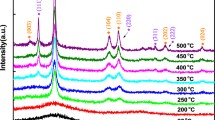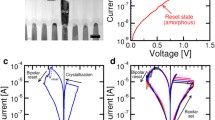Abstract
Chalcogenide thin films are used as the recording medium for phase change-type optical memory discs. The films are switched between amorphous and crystalline states using the heat of a focussed laser beam. Large reflectivity differences between amorphous and crystalline states are then used to store and retrieve the information. An active chalcogenide layer for this purpose should have a high optical absorption coefficient (α), and good structural and thermal stability. It should be possible to switch the chalcogenide layer between amorphous and crystalline states repeatedly within a short duration, the optical contrast should be high, and the material must have large cycling capability. Keeping the above requirements in mind, we have carried out systematic investigation of structural, optical and crystallization behaviour of thin films of various compositions of GaGeTe, Sb2Te3 and BiSe. These studies have shown that these materials can be good candidates for use as recording media in erasable phase-change optical recording.
Similar content being viewed by others
References
Afonso C N, Salis J and Calatind F 1992Appl. Phys. Lett. 60 3123
Barton R, Charles R D, Rubin K and Grace L 1986Appl. Phys. Lett. 48 1255
Bhattacharya R N and Pramanik P 1982J. Electro. Chem. 129 332
Bloomberg D and Connell G 1988Magneto-optical recording (eds) C Mee and E Daniel (New York: McGraw Hill) Vol. 3
Cahn J W 1956Acta Metall. 4 449, 573
Carcia P F, Kalk F D and Swartz D G 1988J. Appl. Phys. 64 1671
Chen H S 1978J. Non-Cryst. Solids 27 257
Chiba R, Yamazaki H, Yagi S and Fujimori S 1993Jap. J. Appl. Phys. 32 834
Chopra K L (ed.) 1973 Optical behaviour of amorphous materials, inOptical behaviour of materials (Delhi: Thomson Press Ltd.)
Christian 1975Theory of phase transformation of metals and alloys (New York: Pergamon Press)
Cline H E and Anthony R T 1977J. Appl. Phys. 48 3895
Dutt A 1990Polym. Commun. 31 451
Gravesteijn D J, Vander Poel, Scholte P M L O and Van Uijen C M J 1989Philips Tech. Rev. 44 250
Henderson D W 1979J. Thermal Anal. 15 325
Marchant A 1990Optical recording—A technical review (Reading, Massachusetts: Addison-Wesley)
Nagto K, Kawamoto A, Sato T and Yorozu T 1986J. Appl. Phys. 63 3856
Noguchi M 1982Appl. Opt. 21 2665
Ovshinsky S R 1970 US Patent # 3, 530, 441
Ovshinsky S R 1992J. Non-Cryst. Solids 141 203
Ozawa T 1971Polymer 12 150
Ramanan V R V and Fisher G E 1982J. Appl. Phys. 53 2273
Reddy G B, Dhar A, Malhotra L K and Sharmila E K 1992Thin Solid Films 220 111
Sestak J 1974Phys. Chem. Glasses 6 137
Sripathi Y, Reddy G B and Malhotra L K 1991J. Mater. Sci.: Materials in Electronics 2 109
Sripathi Y, Reddy G B and Malhotra L K 1992J. Mater. Sci.: Materials in Electronics 3 164
Tanabe T, Tetsuo I and Funakoshi N 1989Jap. J. Appl. Phys. 28 L1845
Vander Poel C J, Gravesteijn D J and Van Uijen C M J 1988J. Appl. Phys. 59 1819
Yinnon H and Uhlmann D R 1983J. Non-Cryst. Solids 54 253
Author information
Authors and Affiliations
Rights and permissions
About this article
Cite this article
Malhotra, L.K., Sripathi, Y. & Reddy, G.B. Material science aspects of phase change optical recording. Bull. Mater. Sci. 18, 725–739 (1995). https://doi.org/10.1007/BF02744807
Issue Date:
DOI: https://doi.org/10.1007/BF02744807




